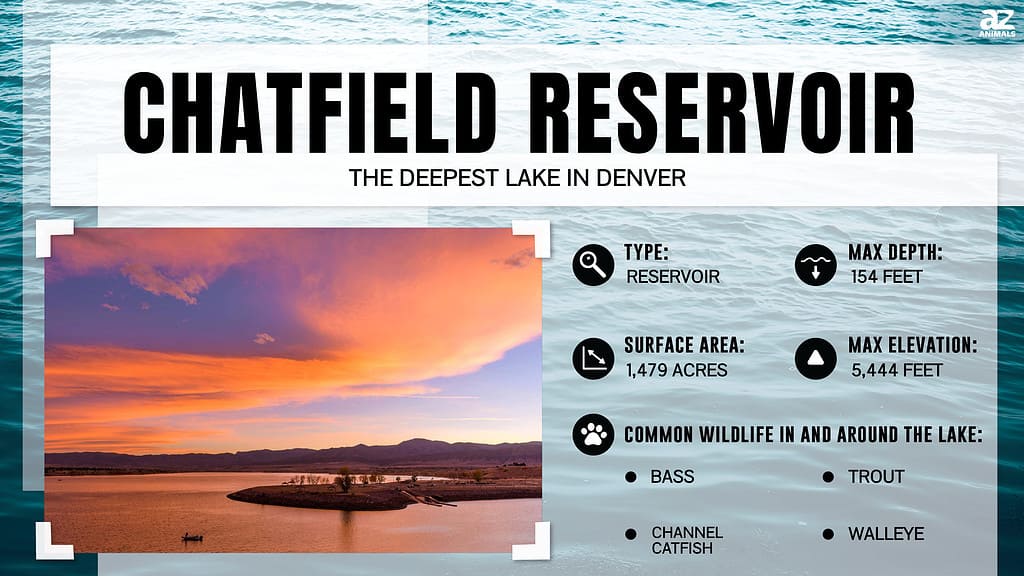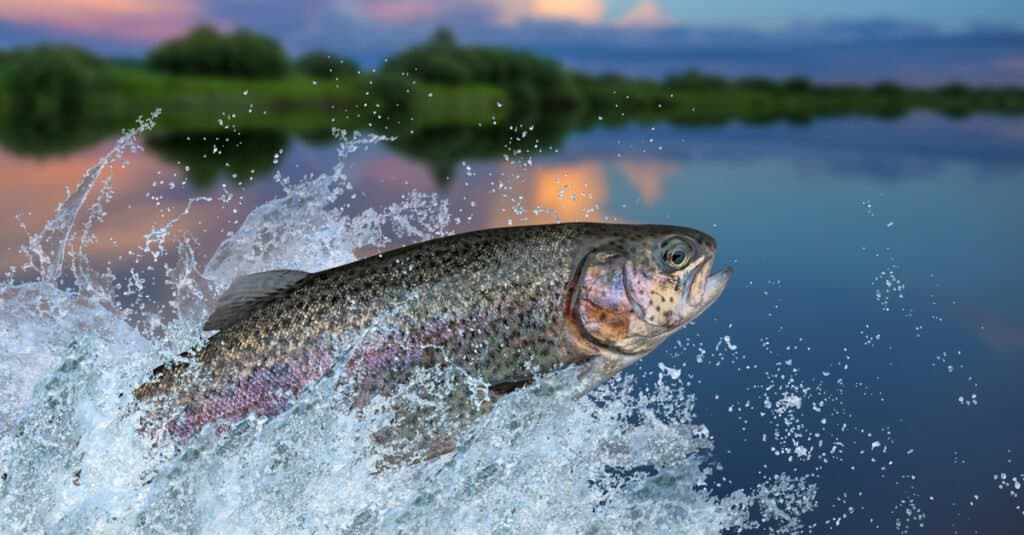Key Points:
- The Chatfield Reservoir is the deepest lake in Denver at a maximum depth of 154 feet.
- Located in the foothills of the Rocky Mountains, the lake was formed as a result of Chatfield Dam built over the South Platte River.
- The reservoir was constructed primarily for flood control, but it also supplies water to the city of Denver and stores around 27,046 acre-feet of water.
The United States of America has about three million natural and man-made lakes. These lakes are great for fishing. They also have stunning views and offer outdoor recreational experiences for people. The City of Denver in Colorado has only 18 public lakes. Many of Colorado’s lakes have a shallow depth. Even the largest lake in the city — Sloan’s Lake — is less than 10 feet deep. However, some of them are quite deep. Read on to discover some interesting facts about the deepest lake in Denver.

The Deepest Lake in Denver

Chatfield Reservoir has an average depth of 47 feet.
©iStock.com/SeanXu
Chatfield Reservoir has an average depth of 47 feet and a maximum depth of 154 feet. This makes it the deepest man-made reservoir and the deepest lake overall in the city of Denver. Located in the foothills of the Rocky Mountains, just 25 miles from downtown Denver, this lake was formed as a result of the dam built over the South Platte River. The lake formed at the confluence of the river with Plum Creek.
Chatfield Dam, which formed this lake, was built by the U.S. Army Corps of Engineers in 1975. The lake was constructed primarily for flood control, but it also supplies water to the city of Denver.
The water of the South Platte River is held back by a massive 13,000-foot-long dam with a maximum height of 147 feet. This means the dam is 100 feet above the mean depth of the reservoir. The lake itself is two miles long and drains an area of approximately 3,018 square miles.
The total surface area of the lake is 1,479 acres, and it stores roughly 27,046 acre-feet of water. Three rivers contribute to the inflow of water into this reservoir. The main one is the South Platte River. Plum Creek and Deer Creek also provide primary and secondary inflows to the reservoir.
Where Is Chatfield Reservoir Located on a Map?
Chatfield Reservoir is in Douglas and Jefferson counties. It is next to the foothills of Littleton in Colorado, and around 20 miles southwest of downtown Denver.
History of Chatfield Reservoir
When the first white settlers arrived in the present-day Chatfield area to prospect for gold in the 1850s, the Native Americans occupying the region warned them about settling in the vicinity of the South Platte River.
In the 1870s, Isaac W. Chatfield, a commander of the Union during the Civil War, ignored this warning when he purchased the land around the South Platte River and Plum Creek confluence. Although he departed the region about a decade later, the settlement of Chatfield and the area around it still bear his name.
The warnings of the Native Americans against settling in the region finally came to pass in the 1900s, when incessant floods along the South Platte River threatened the growing agricultural community.
Major floods that affected the Denver area happened in 1933, 1935, and 1942. However, the biggest one recorded happened in 1965 when the South Platte River flooded and wiped out homes, businesses, and structures in Denver. This flooding event prompted the authorities to commission the construction of the Chatfield Dam over the river.
Construction began in August 1967, two years after the flood. The United States Army Corps of Engineers handled the construction of the project. It took eight years and a total of 85 million dollars to complete the project.
Recreational Activities at Chatfield Reservoir
Although primarily built for flood control, the deepest lake in Denver also provides numerous opportunities for visitors to engage in recreational activities. Before the dam was completed, the government started working on a 5,600-acre recreational area in 1973. The recreational area became open to visitors in 1975.
Boating is one of the most popular activities at the park. Visitors can also engage in a wide range of other water sports, such as skiing, paddling, and sailing. Fishing is also allowed on the lake.
In the park around the lake, visitors can hike or bike the 26 miles of trails. Chatfield also has 197 campsites for visitors who want to stay for a few fun and adventurous days exploring the park.
Fishing on Chatfield Reservoir

The park authorities occasionally stock the lake with rainbow trout and other fish species.
©FedBul/Shutterstock.com
Fishing is allowed at Chatfield Lake, but you’ll require a license from the park authorities. Licenses are available for purchase at the park or on the campgrounds. Fishing is not permitted in certain areas of the lake, including the ponds in the dog off-leash area and the spillway.
The deepest lake in Denver supports a healthy population of bass and trout. You may also find other fish species, such as channel catfish, walleye, crappie, bluegill, carp, and crappie.
The park authorities occasionally stock the lake with rainbow trout and other fish species. The most popular fish for anglers on the lake is trout. In fact, the park is the most popular spot for trout fishing in Denver. Ice fishing is one of the many activities available in the park. Ice-fishing enthusiasts can go out on the frozen lake as conditions permit.
Wildlife at Chatfield Lake Park
There are at least 212 bird species that have been recorded in the Chatfield Reservoir area. Many of these birds permanently nest in the area, while some of them only stop over to rest during their migratory flights. Some of the most popular species in the park include the bald eagle, burrowing owl, and white pelican, among several others.
In addition to the birds, amphibians like the Great Plains toad, American bullfrog, western tiger salamander, and Woodhouse’s toad are found in the park. Different species of lizards and snakes are found here as well. The park is also home to small mammals like rabbits, gophers, beavers, and rats. The American elk is the largest animal you can find at Chatfield Park.
Conclusion
Chatfield Reservoir is the deepest man-made lake in the Denver area. The state park where it is located is one of the most versatile parks in the city, providing loads of outdoor activities for visitors. The reservoir, alongside the park, is a vital resource for Denver and the communities around it because it supplies water for drinking and irrigation and protects natural ecosystems in the area.
The photo featured at the top of this post is © iStock.com/SeanXu
Thank you for reading! Have some feedback for us? Contact the AZ Animals editorial team.






